Green Mortgages?
 With new home production still well below annual historical averages, chances are you’re buying an older homes that needs some work. Believe it or not, there are loans out there that might suit your needs. If you’re planning to replace systems or appliances, consider an energy-efficient loan. Energy- Efficient Mortgages also known as EEMs, are home loans that target home improvement through energy efficiency. They can also be used for new homes that are energy-efficient.
With new home production still well below annual historical averages, chances are you’re buying an older homes that needs some work. Believe it or not, there are loans out there that might suit your needs. If you’re planning to replace systems or appliances, consider an energy-efficient loan. Energy- Efficient Mortgages also known as EEMs, are home loans that target home improvement through energy efficiency. They can also be used for new homes that are energy-efficient.
Energy-Efficient Mortgages
EEMs are conventional, which means they can be sold by the banks to Fannie Mae and Freddie Mac on the secondary market, and they can also be HUD-guaranteed, either FHA or VA-approved. These loans aren’t simple to obtain — the borrower and the home must meet certain criteria for eligibility. ENERGY STAR-rated homes, for example, are new homes that are at least 15% more energy-efficient than homes built to the 2004 International Residential Code (IRC), and they may include additional energy-saving features that typically make them 20–30% more efficient than standard homes, according to energystar.gov. The Federal Housing Administration defines EEMs as any loan that is used to purchase an energy-efficient new home, or to purchase or rehab an existing home in need of energy improvements.
Basically, the EEM allows borrowers to borrow slightly more than their debt-to-income ratio might otherwise allow if the difference is used toward buying a better, more energy-efficient home. The allowance uses the estimated savings in a formula that increases the amount of money a home buyer can qualify to borrow, typically about 5% of the purchase price. EEMs are typically offered on new homes, but the energy efficiency has to be rated by a qualified energy “rater.” Once the lender has the rating, the borrower can make the purchase using the EEM loan.
Energy Improvement Mortgages
Energy Improvement Mortgages (EIMs), are EEMs designed for purchasing preowned homes that will have energy efficiency improvements made to them. The advantage to an EIM is that borrowers can borrow more money to include the cost of energy-efficient improvements, without increasing the size of the down payment. Because an existing home is likely to be inefficient, an energy rater is required to provide the lender with a rating that lets the lender know how much difference the proposed improvements should make. This “Energy Savings Value” determines the cost of the loan.
FHA 203k Loans
The FHA and the VA cap the amount of improvements that can be added to an EEM. The FHA’s cap is $4,000 or 5% of the home’s value, while the VA’s cap is $3,000 to $6,000. According to energystar.gov, an ENERGY STAR mortgage pilot program from the Environmental Protection Agency through HUD, allows improvement costs to be rolled into the mortgage loan, allowing borrowers to deduct the interest on their improvements on their federal and state income taxes. The real carrot on a stick is that borrowers won’t pay more in interest rates for this mortgage than any conventional loan, and that they may qualify for reduced loan fees, discounts, or help with closing costs.
While the FHA insured 203k bank loan isn’t strictly an energy-efficient loan, it’s included here because the loan is intended for older homes in need of home improvement. Older homes are often out of code, or in need of updates that can include energy-efficient purchases such as insulation, new heating and air, and new windows. Qualifying for the 203K loan can be complex, so the FHA has introduced the Streamline 203K, which lenders prefer due to reduced paperwork and a simpler process. The advantage to borrowers is that the streamlined 203K can be used as a purchase loan or as a home improvement loan, and it can be larger than the purchase price of the property. That’s the equivalent of getting a home loan and a home improvement loan in one instrument. Along with new flooring, minor remodeling, plumbing, and electrical, the FHA 203K loan also covers energy-efficient improvements, including new appliance purchases.
What all the loans have in common is that they are special government programs designed to take the risk out of home improvement for lenders and borrowers alike. For that reason, the loans are only offered to home owners who are occupying their homes.
-From Realty Times
